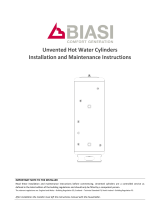Installation
6 720 804 672 (2015/07) 11
3.7 Installation
3.7.1 Connection of the secondary appliance
▶ Connect to the coil ( fig. 2 [1], page 5) using the compression
fittings supplied, either connection can be flow or return,
performance is identical either way. The heating circuit must be
positively pumped as gravity circulation is not possible.
▶ The heating circuit can be open vent or sealed system to a maximum
pressure of 6 bar. If the heating circuit is sealed an expansion vessel,
pressure gauge and pressure relief valve will be required if not
already part of the heating appliance.
▶ The heating appliance may be gas, oil or electric but must be under
effective thermostatic control. Uncontrolled heat sources such as
some AGAs, back boilers and solid fuel stoves are not suitable.
▶ Caution must be taken to prevent an air lock at time of commissioning
the unit, an air vent may be required.
▶ The coil must be able to be drained via a suitable valve.
3.7.2 Connection on the water side
▶ Install the cold water inlet control group as close as possible to the
cylinder cold water inlet, with the compression fittings supplied. The
mains supply must be able to provide the minimum pressure and flow
rates stated in specification table TAB. 4, page 7.
▶ The cold water inlet control group includes a 6 bar expansion relief
anti-vac valve. A discharge pipe must be installed and routed via a
tundish in accordance with current regulations.
▶ Install a drain valve at the cold water inlet.
3.7.3 DHW secondary circulation
Cylinders are equipped with a DHW secondary return connection
(SC 150 to SC 300 cylinders only).
▶ If no DHW secondary circulation is required, blank off and ensure a
water tight seal ( fig. 2 [4], page 5).
Seal and insulate the connection.
▶ When connecting DHW secondary circulation:
Install a DHW circulation pump approved for potable water and a
suitable non-return valve.
Thermal disinfection
Guidance must be taken from current regulations to ensure the risk of
Legionella bacteria growth is prevented.
3.7.4 DHW expansion vessel
▶ Connect the expansion vessel to the cold water inlet control group
using a suitable method to withstand the temperatures that could be
reasonably expected to discharge into the expansion vessel. E.g.
Copper Pipe.
For DHW systems with a large volume:
▶ Check whether the expansion vessel supplied (12, 18 or 25 litres) is
adequate and if required, install an additional expansion vessel in
parallel to the one supplied, ensuring the air charge of each is
identical.
3.7.5 Installing the discharge pipe work from the safety valves
supplied
▶ Locate the cold water inlet control group so that any water flowing
from the expansion relief anti-vac valve will be drained together with
any water discharged from the temperature and pressure relief
valve.
▶ Route the discharge pipework in accordance with part G3,
schedule 1 of the Building Regulations (the following includes the
most important requirements of the Building Regulations).
▶ Install the tundish vertically in direct proximity to the cylinder
(maximum distance between safety valves and tundish 600 mm).
▶ The discharge pipe work must be of a material capable of
withstanding the potential temperatures and pressures.
▶ The following applies for the discharge pipe work downstream of the
tundish:
– Minimum 300 mm vertical drop before the first bend.
– Must be at least one pipe size larger than the inlet of the tundish.
– Route the discharge pipe work with a constant fall.
All hydraulic cylinder connections are suitable for 22 mm
pipes.
▶ Make connections with the compression fittings
supplied.
NOTICE:
▶ If the cold water main is isolated internally or
externally for either emergency or maintenance
reasons, precautions should be taken to prevent
damage to the cylinder. The hot water isolation valve
located at the cylinder outlet should be closed off or
the cylinder should be drained down as per the
recommended procedure stated within this manual.
CAUTION: Damage through excess pressure.
▶ Never restrict the outlets of any safety valves.
Due to the possibility of heat losses, DHW secondary
circulation is only recommended in conjunction with a
DHW secondary circulation pump that is time or
temperature-controlled. The circulation circuit must be
properly insulated.
To ensure safe DHW outlet temperatures thermostatic
mixing valves may be required. Guidance must be taken
from current regulations.
WARNING: Risk of scalding!
Hot water can lead to severe scalding.
▶ Route the discharge pipe work so that any
discharged hot water or steam cannot create a risk.





















